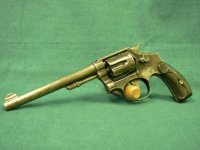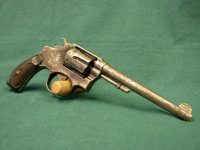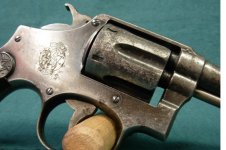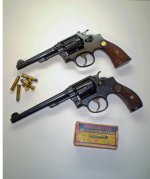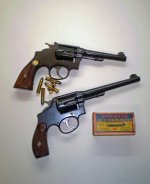You are using an out of date browser. It may not display this or other websites correctly.
You should upgrade or use an alternative browser.
You should upgrade or use an alternative browser.
rust bluing
- Thread starter Nickjc
- Start date
Register to hide this ad
- Joined
- Apr 4, 2006
- Messages
- 19,306
- Reaction score
- 30,221
No I have never tried Rust Bluing, but from what I understand it is hardly worth the price of all the chemicals, equipment and stink to refinish ONE gun. Unless you plan on doing it many times over or for profit I think in the long run you would be much better off and probably get better results just "biting the bullet" and sending it back to S&W or to a Pro.
If all you plan to do is the ONE gun and are only interested in producing "a shooter", one other option would be one of the Duracoat or similar type spray-on finishes. I personally am not a fan, but some like the look.
If all you plan to do is the ONE gun and are only interested in producing "a shooter", one other option would be one of the Duracoat or similar type spray-on finishes. I personally am not a fan, but some like the look.
Last edited:
Pisgah
Member
I'm not sure what chief38 is referring to, but rust bluing is one of the least materials-and-equipment-intensive processes you can do. What it takes is time, patience and persistence. The process itself is very simple, and one $30 bottle of something like Brownell's American Classic Solution (formerly Pilkington's) will do several guns. Other than that all you'll need is steel wool for carding, a stainless steel pot to boil water in, and lots and lots of elbow grease. I once bought a much-abused Model 36 for a song and rust blued it over a 7-day period. The result brought me many, many compliments, years of use, and a profit when I eventually sold it.
Last edited:
JohnHL
SWCA Member
That's interesting, Pisgah!
I have never done any bluing other than cold bluing some small parts. When I think of bluing, the gas fired tanks and "creeping salts" comes to mind.
Would you be so kind as to describe rust bluing and your method.
Thanks!
John
I have never done any bluing other than cold bluing some small parts. When I think of bluing, the gas fired tanks and "creeping salts" comes to mind.
Would you be so kind as to describe rust bluing and your method.
Thanks!
John
Pisgah
Member
That's interesting, Pisgah!
I have never done any bluing other than cold bluing some small parts. When I think of bluing, the gas fired tanks and "creeping salts" comes to mind.
Would you be so kind as to describe rust bluing and your method.
Thanks!
John
Most if not all rust bluing solutions will come with complete instructions, but basically here it is.
First, prepare the parts to be blued. This means cleaning and removing all rust and doing what you can to file or stone away pits. You want as even a polish as you can get over the entire surface, but don't go too far; a good rust blue finish will have a more-or-less matte appearance, and too fine a polish can actually slow the process. Once the polish is complete, thoroughly degrease everything. From this point forward, avoiding skin-to-metal contact is highly recommended. Cotton gloves are a good idea. Keeps skin oils off the metal.
Apply the rusting solution evenly using a cotton swab or bit of clean cotton cloth. I use bits of wire to form hooks that allow me to hang the parts so air can circulate freely around them. Allow a thin coat of rust to form on all surfaces. Time for this to occur will vary with the conditions; warm and humid works faster than cool and dry, but given sufficient time a good solution will work even in less-than-ideal conditions.
Once the rust coat has formed, submerge parts in clean boiling water. If your water supply is highly mineralized, you might want to go with distilled water for this, but I have never found that to be necessary. After a few minutes in the bath, remove parts and card off all the rust using fine steel wool.
At this point, everything will look gosh-awful and you will be convinced you have ruined a gun. Be brave; you've only just begun! Apply the solution again; allow the rust to form; boil; card again. Repeat as many times as needed until you get the finish you want. I have completed a gun in as little as two days; other times, it has taken two weeks. Once you're there soak the whole shebang with oil while the metal is still warm and let it sit for several hours. Then wipe off the excess oil, reassemble the gun, and admire your handiwork.
Interestingly, if you want to brown a firearm you can use the same solution and the same process, minus the boiling bath. A deep, rich, smooth chocolate brown finish makes a handsome gun.
Last edited:
TAROMAN
US Veteran
Here's a great rust bluing primer courtesy of Guns Magazine:
The DIY Rust Blue
The DIY Rust Blue
Babalooie
US Veteran
I have used Birchwood Casey Plum Brown. It produces a rust finish. It's not that difficult and if done properly, looks pretty good on older guns.
Basically, you remove the blue finish; smooth out all surfaces with steel wool or a grey scotch brite pad; heat the metal with a torch or heat gun till it's hot to the touch; rub a rag soaked with the solution on the hot metal (use adequate ventilation); neutralize the solution with water; dry and apply a light coat of oil (Remoil or equal); and you're done.
It sounds more complicated than it really is. Having done it to several very old rifles, I found it really easy once I overcame the fear of screwing it up. You can always redo it if it comes out splotchy.
Keep in mind that you will end up with a Model 15 with a rust finish. If you try it and decide to try cold bluing instead, just take a wire wheel to it and finish off with the scotch brite pads.
Hey, I just looked at the DIY article above. What I was referring to, is not that process.
Basically, you remove the blue finish; smooth out all surfaces with steel wool or a grey scotch brite pad; heat the metal with a torch or heat gun till it's hot to the touch; rub a rag soaked with the solution on the hot metal (use adequate ventilation); neutralize the solution with water; dry and apply a light coat of oil (Remoil or equal); and you're done.
It sounds more complicated than it really is. Having done it to several very old rifles, I found it really easy once I overcame the fear of screwing it up. You can always redo it if it comes out splotchy.
Keep in mind that you will end up with a Model 15 with a rust finish. If you try it and decide to try cold bluing instead, just take a wire wheel to it and finish off with the scotch brite pads.
Hey, I just looked at the DIY article above. What I was referring to, is not that process.
Last edited:
gwpercle
Member
Rust bluing isn't hard nor does it involve a lot of equipment, it does involve a lot of hand work , time and the need to be performed correctly. Someone on this site , hand polished and rust blued a revolver and it turned out gorgeous. Just took a lot of tedious hand work . That's why factories no longer do it.
He got everything from Brownell's and followed the instructions.
Gary
He got everything from Brownell's and followed the instructions.
Gary
Last edited:
tlay
US Veteran
I do hot tank bluing, brownells setup, and have done a few rust blues. Some guns seem to take the rust bluing in as low as 5 coats for a dark finish and others as many as 20. I just finished an LC Smith double barrel hammer gun that took 17 coats. I wont do another! It is a lot of work on a double barrel. But you cant hot blue these old double barrels so rust bluing is what most people do.
It is a lot of work on a double barrel. But you cant hot blue these old double barrels so rust bluing is what most people do.
I used the Pilkingtons solution. There are a lot of different types and each has a little variation on the same process. Check Brownells for their products.
I used the Pilkingtons solution. There are a lot of different types and each has a little variation on the same process. Check Brownells for their products.
Interesting, have a couple guns to do and hear the cold blue isn't durable even if you heat the guns. Anyone have a humidity chamber, how hard is it to build? How about some pics of completed guns, would like to see the depth of the blue. Larry
I started out using rust browning/bluing to restore finish to damascus & steel doublegun barrels. You will read quite a bit about browning muzzle-loading kit guns online. Building a 1700's flintlock of percussion usually ends in browning the parts rather than bluing. Both processes are the same except that browning process eliminates boiling the parts. As you boil, the red oxide is transformed to black ferro-ferric oxide.
Do a search of the Internet and look for videos of doing the process. Most claim only a few rust cycles will do the job, but I have found that to get a deep uniform finish, many repeats are necessary. If the humidity is high, you can do two rust cycles a day.
The process is quite simple as noted by others and only a few hard and fast rules need to be followed. First, decide if you want a polished blue finish or just to rust blue existing surface. The first option takes a lot of time and experience to remove shallow pitting, surface scratches, etc. without dishing the metal or rounding the corners. Second, is clean - clean - clean the metal and do a final cleaning by boiling all parts in TSP and water to remove all traces of oil in the cracks and crevices of the revolver. Third, provide a humid environment for the rust process. Try a large wet sponge placed under a tented enclosure with the parts to make sure uniform rusting is forming. Use rubber gloves and never touch any parts with bare hands. If you do any sanding, end the process with nothing finer than 400 grit. Don't forget to plug the barrel before rusting. I use small rubber stoppers, but you can fit wood plugs as well.
Lastly, patience is a virtue in this process, since you will need to rust, card, boil, and repeat up to 12-15 times for most guns to get a complete and uniform coverage. The process of carding is explained in many different ways, but I have found that using 0000 steel wool gives me the best results. It might seem counter to the process, but the goal of carding is to remove as much finish as possible after each rusting, and over time, the finish will appear and deepen with each application of rust blue. Lastly, boil in caustic water to neutralize the parts. Any trace of rusting acid will continue to work and ruin your fresh new finish. It lurks in the thread holes, in the threads of the barrel in the frame, and other places you would never think of. I use a crystalline drain cleaner and dissolve it in boiling water.
Here is a 32 Winchester shooter I rescued from a sad state. Only sanding done was to remove the pitting on the cylinder and barrel before the process. I use Naval Jelly to remove the old finish and buff with steel wool. The refinished 32 HE is the one on the bottom, with an original finish 32 Winchester Target at the top.
Good luck with your project.
Do a search of the Internet and look for videos of doing the process. Most claim only a few rust cycles will do the job, but I have found that to get a deep uniform finish, many repeats are necessary. If the humidity is high, you can do two rust cycles a day.
The process is quite simple as noted by others and only a few hard and fast rules need to be followed. First, decide if you want a polished blue finish or just to rust blue existing surface. The first option takes a lot of time and experience to remove shallow pitting, surface scratches, etc. without dishing the metal or rounding the corners. Second, is clean - clean - clean the metal and do a final cleaning by boiling all parts in TSP and water to remove all traces of oil in the cracks and crevices of the revolver. Third, provide a humid environment for the rust process. Try a large wet sponge placed under a tented enclosure with the parts to make sure uniform rusting is forming. Use rubber gloves and never touch any parts with bare hands. If you do any sanding, end the process with nothing finer than 400 grit. Don't forget to plug the barrel before rusting. I use small rubber stoppers, but you can fit wood plugs as well.
Lastly, patience is a virtue in this process, since you will need to rust, card, boil, and repeat up to 12-15 times for most guns to get a complete and uniform coverage. The process of carding is explained in many different ways, but I have found that using 0000 steel wool gives me the best results. It might seem counter to the process, but the goal of carding is to remove as much finish as possible after each rusting, and over time, the finish will appear and deepen with each application of rust blue. Lastly, boil in caustic water to neutralize the parts. Any trace of rusting acid will continue to work and ruin your fresh new finish. It lurks in the thread holes, in the threads of the barrel in the frame, and other places you would never think of. I use a crystalline drain cleaner and dissolve it in boiling water.
Here is a 32 Winchester shooter I rescued from a sad state. Only sanding done was to remove the pitting on the cylinder and barrel before the process. I use Naval Jelly to remove the old finish and buff with steel wool. The refinished 32 HE is the one on the bottom, with an original finish 32 Winchester Target at the top.
Good luck with your project.
Attachments
Pisgah
Member
Interesting, have a couple guns to do and hear the cold blue isn't durable even if you heat the guns. Anyone have a humidity chamber, how hard is it to build? How about some pics of completed guns, would like to see the depth of the blue. Larry
Don't confuse cold bluing with rust bluing. The two are completely different, and rust bluing is every bit as durable as hot tank bluing -- I think maybe a bit more durable.
I don't have a rust-blued gun right now, but I would describe the typical rust blue as more black than blue, and usually with a matte appearance. This appearance is not solely due to the polish. Although most guns to be rust-blued are not given a high polish due to the fact that a slightly more coarse polish (say, 220 grit vs. 400) takes the finish quicker, even a high polish will result in a less-than-mirror-like look in the finished product. A two-word description would be, "deep, rich".
A humidity cabinet is not really needed usually unless you live in an extremely cold/dry climate, or are in a hurry to finish the job. But rigging one up is no big job. A friend built a small wooden box that used a shallow pan of water for humidity and a 100-watt bulb for heat. Another guy I know used one for doing rifle and shotgun barrels that was cobbled up from a length of 6" PVC pipe.
Last edited:
gwpercle
Member
The quick and easy "humidity box" I saw instructions for was just a heavy cardboard box with the small pan of water and the 100 watt light (a auto mechanic's hand held utility light ) placed inside the box.
Gary
Gary
I did hundreds of rust blue jobs over the years,
The process is a simple one as described above.
Less than perfectly clean surfaces, tank, application equip, hangers, carding supplys, ect will spoil a job every time.
Water that has minerals in it will leave a spot on the surface where the last drop evaporates as you pull it from the tank,,a small area of dried mineral deposit to spoil the finish.
Old oil and grease dislodged from in between the ribs of SxS bbls,,from screw threads, corners and crevises or parts will contaminate the water immediately and cling to the metal surface as you pull them from it. Then you card the part and smeart hat contamination all over it and your carding wheel (if you are using one) and pass it along to the next cycle.
Clean the tank before you use it,,clean the parts so there's no contamination on them. Pour out a small amt of your rusting soln into a shallow container to work from and NEVER pour any of that back into the main bottle. If you do,,that main bottle will be contaminated sure as hell..
I change the water in the tank after every 3 rusting/boiling cycles. It'll get dirty/brown looking and any contamination will be cleaned out at the same time.
I collect and use A/C condensate for my water. I try to collect around 60 to 70 gal durring the summer for use during the rest of the year. Some say the condensate running off the copper coils in the A/C leaches copper into the waterand spoils the bluing, but I've never had any problems in 40 yrs of this.
Some have municiple water that works fine,,it'll tell you right off. The red rust will either change to black and easily card off or it won't.
Rain water can work as can melted snow, both depend on .location and contamination in the air and collection methods.
As far as rusting methods,,hot humid summertime is nice,,but we don't always have that. The best and easiest rusting cabinet I've found is the bathroom. Hang the parts from the shower rod,,turn the shower on hot for a couple minutes with the tub stoppered to collect the water and close the door. Steam up the room. Turn off the water and leave, close the door behind you.
Rusting time 1 to 2 hrs depending on the steel type and the soln you are using. Check on the parts after 1/2hr and if needed turn the hot water on again the steam things up again and leave.
You might want to let the others in the house know whats going on first.
I don't plug bbls either when rusting or when boiling.
I do coat the bores w/shellac for damascus finishing as they have to go thru an etching dip as part of the process.
320 grit polish is about right for most jobs,,don't let the things rust too long. No need for a heavy red rust to form to get a blueing coat.
In fact I check them by feeling the part very lightly with my hands, I slide my fingers down the part and if I can feel the roughness of the rust coating even though I can't see any substantial rusting,,I pull them down and boil them. It avoids the heavy matted finish and you still get the layer of color.
That's part of the trick if there is any to the high gloss rust blue seen on the English guns. That and lower humidity and weaker rusting solns.
Anyway,,card completely, let the carding wheel do the work and don't push down too hard. If you use steel wool to card,,clean it of all the oil that placed in it for rust prevention before use. It's tough to remove it even w/ acetone. Some use stainless steel=wool. I've always just used carding brushes(hand) or a carding wheel.
If you do encounter a streak or blemish in the blue don't panic,,take a piece of clean scotchbrite and polish that area down till the blemish is gone and the area polish lines match the surrounding ones.
You will have taken most if not all of the blue off of that blemished or streaked area in the process,,but go ahead and put another coating of soln on the entire part.
Don't try and put extra on the area you just thinned down to bare steel,,,just a plain even coating over everything.
There is still rust blue in the pores of the steel in that thinned out area and this one new coat will bring the blemished repaired area back to if not full matching color then very close to it. A second full coat may be needed to fully match it up and then you can continue or quit right there.
I use Laurel Mtn Forge for slow rust bluing. It does have a tendency to after rust. So soak the parts in a weak alkali soln after wards to kill the weak acidic ph soln that it is (ferric chloride). Even then it can be still aggressive.
The best after rust preventative I've found for LMF is one coating of express rust blue right over the top of the last coating of the LMF. I use Mark Lee's Express Blue. For some reason absolutely no after rust.
Hope this helps.
The process is a simple one as described above.
Less than perfectly clean surfaces, tank, application equip, hangers, carding supplys, ect will spoil a job every time.
Water that has minerals in it will leave a spot on the surface where the last drop evaporates as you pull it from the tank,,a small area of dried mineral deposit to spoil the finish.
Old oil and grease dislodged from in between the ribs of SxS bbls,,from screw threads, corners and crevises or parts will contaminate the water immediately and cling to the metal surface as you pull them from it. Then you card the part and smeart hat contamination all over it and your carding wheel (if you are using one) and pass it along to the next cycle.
Clean the tank before you use it,,clean the parts so there's no contamination on them. Pour out a small amt of your rusting soln into a shallow container to work from and NEVER pour any of that back into the main bottle. If you do,,that main bottle will be contaminated sure as hell..
I change the water in the tank after every 3 rusting/boiling cycles. It'll get dirty/brown looking and any contamination will be cleaned out at the same time.
I collect and use A/C condensate for my water. I try to collect around 60 to 70 gal durring the summer for use during the rest of the year. Some say the condensate running off the copper coils in the A/C leaches copper into the waterand spoils the bluing, but I've never had any problems in 40 yrs of this.
Some have municiple water that works fine,,it'll tell you right off. The red rust will either change to black and easily card off or it won't.
Rain water can work as can melted snow, both depend on .location and contamination in the air and collection methods.
As far as rusting methods,,hot humid summertime is nice,,but we don't always have that. The best and easiest rusting cabinet I've found is the bathroom. Hang the parts from the shower rod,,turn the shower on hot for a couple minutes with the tub stoppered to collect the water and close the door. Steam up the room. Turn off the water and leave, close the door behind you.
Rusting time 1 to 2 hrs depending on the steel type and the soln you are using. Check on the parts after 1/2hr and if needed turn the hot water on again the steam things up again and leave.
You might want to let the others in the house know whats going on first.
I don't plug bbls either when rusting or when boiling.
I do coat the bores w/shellac for damascus finishing as they have to go thru an etching dip as part of the process.
320 grit polish is about right for most jobs,,don't let the things rust too long. No need for a heavy red rust to form to get a blueing coat.
In fact I check them by feeling the part very lightly with my hands, I slide my fingers down the part and if I can feel the roughness of the rust coating even though I can't see any substantial rusting,,I pull them down and boil them. It avoids the heavy matted finish and you still get the layer of color.
That's part of the trick if there is any to the high gloss rust blue seen on the English guns. That and lower humidity and weaker rusting solns.
Anyway,,card completely, let the carding wheel do the work and don't push down too hard. If you use steel wool to card,,clean it of all the oil that placed in it for rust prevention before use. It's tough to remove it even w/ acetone. Some use stainless steel=wool. I've always just used carding brushes(hand) or a carding wheel.
If you do encounter a streak or blemish in the blue don't panic,,take a piece of clean scotchbrite and polish that area down till the blemish is gone and the area polish lines match the surrounding ones.
You will have taken most if not all of the blue off of that blemished or streaked area in the process,,but go ahead and put another coating of soln on the entire part.
Don't try and put extra on the area you just thinned down to bare steel,,,just a plain even coating over everything.
There is still rust blue in the pores of the steel in that thinned out area and this one new coat will bring the blemished repaired area back to if not full matching color then very close to it. A second full coat may be needed to fully match it up and then you can continue or quit right there.
I use Laurel Mtn Forge for slow rust bluing. It does have a tendency to after rust. So soak the parts in a weak alkali soln after wards to kill the weak acidic ph soln that it is (ferric chloride). Even then it can be still aggressive.
The best after rust preventative I've found for LMF is one coating of express rust blue right over the top of the last coating of the LMF. I use Mark Lee's Express Blue. For some reason absolutely no after rust.
Hope this helps.
Last edited:

